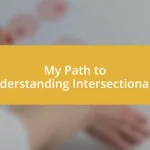Key takeaways:
- Accessible education encompasses physical accommodations and adaptive teaching methods, enhancing learning for all students.
- Building supportive learning communities fosters trust, resilience, and mentorship among students, empowering their academic journeys.
- Advocacy for inclusive practices is essential for creating equitable educational environments, highlighting the importance of understanding diverse perspectives.

Understanding Accessible Education
Accessible education is about creating learning environments that consider the diverse needs of all students, including those with disabilities. I remember a time in school when a classmate, who used a wheelchair, faced enormous barriers just to navigate our campus. It struck me then, and still resonates with me now—why should anyone’s journey to education be hindered by their physical limitations?
In my experience, accessible education goes beyond ramps and specialized tools. It also includes adapting teaching methods to cater to various learning styles. For instance, I once had a professor who used sign language and visual aids in a lecture, which profoundly impacted the learning experience for everyone in the room. Isn’t it fascinating how inclusive practices can enrich the educational experience for all students, not just those with specific needs?
I often wonder about the ripple effect of accessible education on society. When education is truly accessible, it fosters not only individual success but also community advancement. I’ve seen firsthand how inclusive classrooms celebrate diversity, encouraging compassion and understanding among students. This kind of environment isn’t just nice to have; it’s essential for nurturing the next generation of leaders.

Personal Challenges Faced
As I navigated my own educational journey, I encountered several personal challenges that tested my resilience and adaptability. Early on, I struggled with balancing academic demands and my responsibilities at home. There were times when I felt overwhelmed, but it taught me the importance of time management and prioritization.
- Learning to advocate for my needs was another hurdle.
- I often felt hesitant to ask for accommodations, fearing judgment from peers.
- The constant pressure to fit in sometimes overshadowed my desire to express my needs.
These experiences shaped my understanding of how crucial it is for educational systems to recognize and support individual challenges, not just for myself but for every student who deserves that same opportunity for growth.

Discovering Available Resources
Discovering available resources for accessible education can be both exciting and daunting. I still remember the thrill of learning about various programs and tools that cater specifically to different needs. One resource that stood out to me was an online platform providing free assistive technology training. I never imagined that something so simple could open doors to learning for so many students. Have you ever stumbled upon a resource that transformed your approach to a subject? I certainly did, and it changed the way I viewed education itself.
When I dove deeper into the world of accessible resources, I discovered that many institutions are now collaborating with nonprofits to create tailored materials. For example, my community college partnered with an organization that specializes in adaptive learning tools. This collaboration led to the creation of custom textbooks that include audio components and Braille options, making education more inclusive than ever. I was genuinely impressed by the creativity involved in addressing diverse learning modes.
| Resource Type | Details |
|---|---|
| Assistive Technology Training | Provides knowledge on tools that aid learning, such as screen readers and speech-to-text software. |
| Adaptive Learning Materials | Custom textbooks with audio components and Braille, designed for varied learning styles. |

Implementing Adaptive Learning Strategies
Implementing adaptive learning strategies can truly transform the educational experience. When I first encountered personalized learning tools, it felt like discovering a key that unlocked a room filled with possibilities. For instance, I remember using a software that adjusted the difficulty of math problems based on my responses. This immediate feedback not only boosted my confidence but also kept me engaged in a subject I once found daunting. Have you ever experienced a moment where something just clicked? That’s the magic of adaptive learning in action.
One of the most rewarding aspects of these strategies is how they cater specifically to individual learning styles. I had a friend who struggled with conventional learning methods, often feeling lost in lecture halls. When your education can reshape itself around your unique needs, it fosters a sense of empowerment. We often shared our progress over coffee, and I noticed the change in him. With adaptive tools, his comprehension soared, allowing him to participate more actively in class. Isn’t it incredible how a tailored approach can elevate someone’s ability to thrive?
In my experience, successful implementation requires ongoing communication between students and educators. I vividly recall a discussion with my instructor about needing more visual aids. It wasn’t just about my personal preference; it opened up a broader conversation about how visual learners could benefit from a richer array of resources. That collaborative spirit not only improved my learning but also enhanced the overall classroom environment. Have you ever felt the power of your voice being heard when it comes to your education? It reinforces the idea that adaptive learning isn’t just a strategy; it’s a partnership.

Building Supportive Learning Communities
Building supportive learning communities starts with the essential ingredient of trust. I remember a pivotal moment in my education when I was surrounded by peers who genuinely wanted to help each other succeed. This environment fostered open communication and allowed for vulnerable discussions about our challenges. Have you ever been part of a group where you felt completely supported? It’s a powerful motivator that propels everyone forward.
Forming authentic connections not only enhances learning but also builds resilience among students. I once participated in a study group that met weekly, where we shared our struggles and celebrated our victories, both big and small. I could see how much it meant to everyone to have a place where they felt understood. Isn’t it remarkable how shared experiences can strengthen bonds? These connections are the bedrock of a thriving learning community.
Additionally, creating spaces for mentorship can profoundly impact students’ journeys. I’m fortunate to have had a mentor who was always there to guide me through my struggles. Their encouragement made me feel as though my goals were within reach, igniting my passion for learning. Have you ever had someone believe in you when you doubted yourself? That level of support can inspire students to step outside their comfort zones and strive for greatness. Building supportive learning communities is all about cultivating these connections that empower us to reach our full potential.

Advocacy for Inclusive Practices
Advocacy for inclusive practices is a fundamental pillar in creating equitable educational environments. I distinctly recall attending a workshop where a passionate educator shared her struggles advocating for her students with disabilities. The way she articulated her challenges and triumphs resonated with me. Have you ever felt that fire ignite within you when someone speaks your truth? It was a profound reminder that our voice can effect real change, driving us to push for more inclusive policies and practices.
In my journey, I’ve often witnessed the difference that a strong advocate can make. I remember my own experiences during high school when teachers began to recognize the importance of varied assessment methods. One of my teachers implemented alternative projects that allowed me to showcase my strengths instead of fitting into a rigid testing framework. It was empowering to see how a simple change in perspective could unlock potential for everyone in the classroom. Doesn’t it inspire you to think about how inclusive practices can open doors for those who might feel overlooked?
Ultimately, advocating for inclusive practices involves a personal commitment to understanding diverse perspectives. I still think back to a time when I attended a community meeting focused on accessibility in education. Listening to parents, students, and educators share their stories cultivated a deeper appreciation for the vast spectrum of needs. It challenged my assumptions and sparked a desire to contribute to a more inclusive environment. Have you ever left a conversation feeling positively transformed? That’s the strength of advocacy—connecting individual experiences to a larger movement for change.

Reflecting on Progress and Growth
Reflecting on my progress and growth in accessible education has shown me how far I’ve come. I remember feeling overwhelmed at first, navigating the complex landscape of resources and support systems. There was a moment when I finally understood the importance of advocating for myself, realizing that I had the power to drive my own educational journey. Have you ever had that lightbulb moment when everything just clicks? It’s incredibly empowering.
As I look back, I can’t help but smile at the small victories along the way. There were days when I struggled with self-doubt, questioning if I truly deserved to be in certain spaces. Yet, with each achievement—whether it was mastering a challenging concept or finally receiving the support I needed—I grew more confident in my abilities. Isn’t it uplifting to reflect on how every little success contributes to our overall growth?
I’ve also learned that growth isn’t just about individual success; it’s about lifting others as we climb. I recall participating in an outreach program where I could share my experiences with younger students facing similar challenges. Seeing their eyes light up with hope and inspiration fueled a deep sense of purpose in me. Have you experienced that joy of giving back? It’s a reminder that our journeys can be interconnected, each step forward creating opportunities for others.














